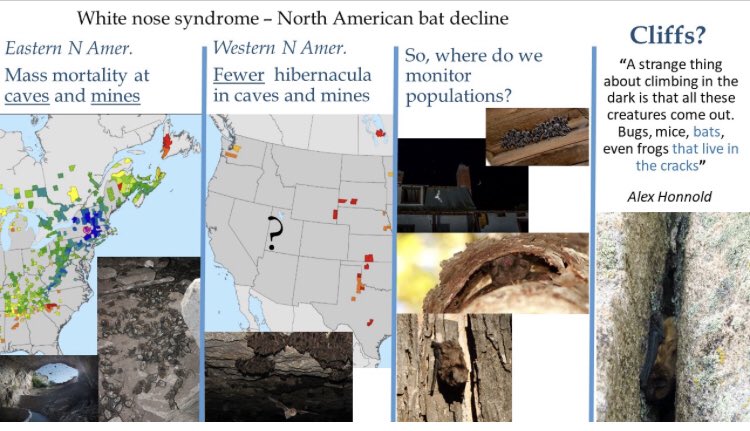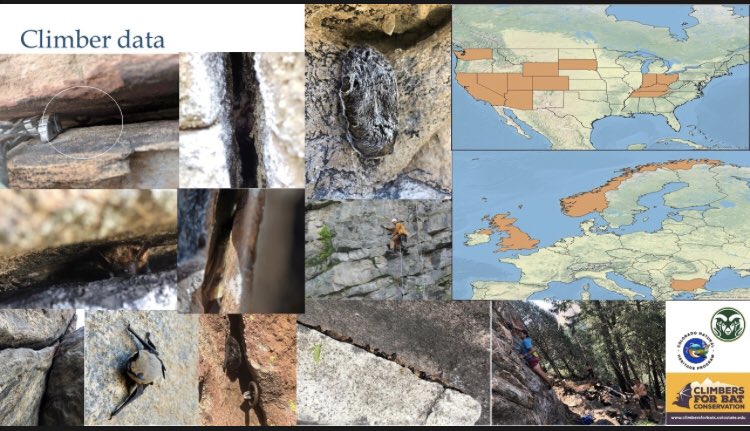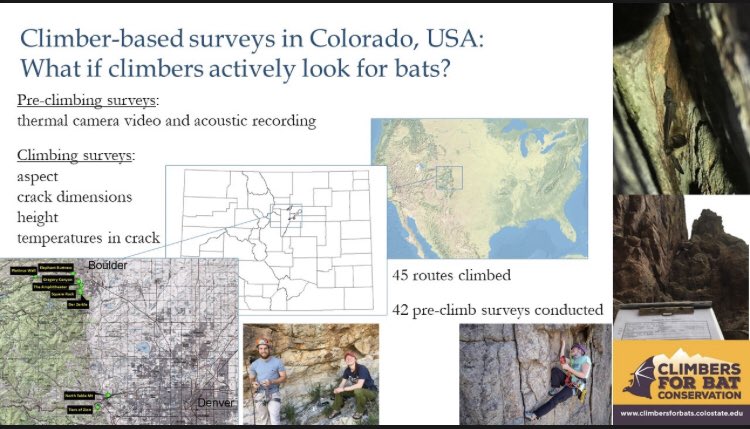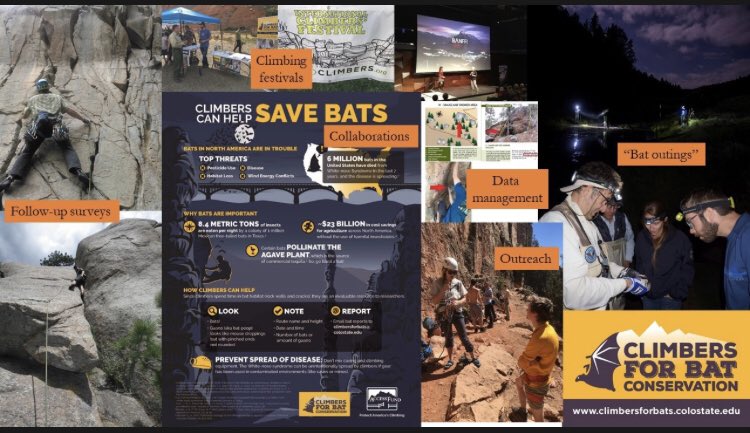1/5. #WBTC1 #Conserve3. I’m Rob Schorr @ColoradoStateU. When WNS hit eastern NAmer, #bats mortality was obvious. When WNS hit western NAmer, mortality was much less obvious. Fewer cave/mine hibernacula in the West. Where should biologists monitor  https://abs.twimg.com/emoji/v2/... draggable="false" alt="🦇" title="Bat" aria-label="Emoji: Bat">? Maybe cliffs!
https://abs.twimg.com/emoji/v2/... draggable="false" alt="🦇" title="Bat" aria-label="Emoji: Bat">? Maybe cliffs!  https://abs.twimg.com/emoji/v2/... draggable="false" alt="🤔" title="Thinking face" aria-label="Emoji: Thinking face">
https://abs.twimg.com/emoji/v2/... draggable="false" alt="🤔" title="Thinking face" aria-label="Emoji: Thinking face">
2/5. #WBTC1 #Conserve3 Climbers for Bat Conservation is a collaboration among #climbers, biologists, and land managers ( @SOGES_CSU, @accessfund, @USFWS, @petzl_fondation, @COParksWildlife, @WGFD) to understand where bats roost and where populations might be.
3/5 #WBTC1 #Conserve3 Climbers see  https://abs.twimg.com/emoji/v2/... draggable="false" alt="🦇" title="Bat" aria-label="Emoji: Bat">in natural rock roosts. Currently 70 records from 12 states, UK, Bulgaria, Norway. Most are of single
https://abs.twimg.com/emoji/v2/... draggable="false" alt="🦇" title="Bat" aria-label="Emoji: Bat">in natural rock roosts. Currently 70 records from 12 states, UK, Bulgaria, Norway. Most are of single  https://abs.twimg.com/emoji/v2/... draggable="false" alt="🦇" title="Bat" aria-label="Emoji: Bat">, but a few of 100s and 1000s of bats. We now have climbers as surveyors and ambassadors for
https://abs.twimg.com/emoji/v2/... draggable="false" alt="🦇" title="Bat" aria-label="Emoji: Bat">, but a few of 100s and 1000s of bats. We now have climbers as surveyors and ambassadors for  https://abs.twimg.com/emoji/v2/... draggable="false" alt="🦇" title="Bat" aria-label="Emoji: Bat">conservation.
https://abs.twimg.com/emoji/v2/... draggable="false" alt="🦇" title="Bat" aria-label="Emoji: Bat">conservation.
4/5 #WBTC1 #Conserve3 What if you hire climbers to look for bats? 50 km W of Denver, Colorado, USA. Pre-climbing surveys and climbing surveys. 42 pre-climb surveys, 45 climbing. 2  https://abs.twimg.com/emoji/v2/... draggable="false" alt="🦇" title="Bat" aria-label="Emoji: Bat"> found: Myotis evotis, Eptesicis fuscus. 1cm cracks, east-facing, 10–12m high
https://abs.twimg.com/emoji/v2/... draggable="false" alt="🦇" title="Bat" aria-label="Emoji: Bat"> found: Myotis evotis, Eptesicis fuscus. 1cm cracks, east-facing, 10–12m high
5/5 #WBTC1 #Conserve3 Next steps: online data portal for data submission; visit routes where climbers have seen  https://abs.twimg.com/emoji/v2/... draggable="false" alt="🦇" title="Bat" aria-label="Emoji: Bat">; engage with climbers at festivals and show them bats; and collaborate with climbing orgs! See a
https://abs.twimg.com/emoji/v2/... draggable="false" alt="🦇" title="Bat" aria-label="Emoji: Bat">; engage with climbers at festivals and show them bats; and collaborate with climbing orgs! See a  https://abs.twimg.com/emoji/v2/... draggable="false" alt="🦇" title="Bat" aria-label="Emoji: Bat">while climbing, let us know! email: climbersforbats@colostate.edu
https://abs.twimg.com/emoji/v2/... draggable="false" alt="🦇" title="Bat" aria-label="Emoji: Bat">while climbing, let us know! email: climbersforbats@colostate.edu

 Read on Twitter
Read on Twitter ? Maybe cliffs! https://abs.twimg.com/emoji/v2/... draggable="false" alt="🤔" title="Thinking face" aria-label="Emoji: Thinking face">" title="1/5. #WBTC1 #Conserve3. I’m Rob Schorr @ColoradoStateU. When WNS hit eastern NAmer, #bats mortality was obvious. When WNS hit western NAmer, mortality was much less obvious. Fewer cave/mine hibernacula in the West. Where should biologists monitor https://abs.twimg.com/emoji/v2/... draggable="false" alt="🦇" title="Bat" aria-label="Emoji: Bat">? Maybe cliffs! https://abs.twimg.com/emoji/v2/... draggable="false" alt="🤔" title="Thinking face" aria-label="Emoji: Thinking face">" class="img-responsive" style="max-width:100%;"/>
? Maybe cliffs! https://abs.twimg.com/emoji/v2/... draggable="false" alt="🤔" title="Thinking face" aria-label="Emoji: Thinking face">" title="1/5. #WBTC1 #Conserve3. I’m Rob Schorr @ColoradoStateU. When WNS hit eastern NAmer, #bats mortality was obvious. When WNS hit western NAmer, mortality was much less obvious. Fewer cave/mine hibernacula in the West. Where should biologists monitor https://abs.twimg.com/emoji/v2/... draggable="false" alt="🦇" title="Bat" aria-label="Emoji: Bat">? Maybe cliffs! https://abs.twimg.com/emoji/v2/... draggable="false" alt="🤔" title="Thinking face" aria-label="Emoji: Thinking face">" class="img-responsive" style="max-width:100%;"/>

 in natural rock roosts. Currently 70 records from 12 states, UK, Bulgaria, Norway. Most are of single https://abs.twimg.com/emoji/v2/... draggable="false" alt="🦇" title="Bat" aria-label="Emoji: Bat">, but a few of 100s and 1000s of bats. We now have climbers as surveyors and ambassadors for https://abs.twimg.com/emoji/v2/... draggable="false" alt="🦇" title="Bat" aria-label="Emoji: Bat">conservation." title="3/5 #WBTC1 #Conserve3 Climbers see https://abs.twimg.com/emoji/v2/... draggable="false" alt="🦇" title="Bat" aria-label="Emoji: Bat">in natural rock roosts. Currently 70 records from 12 states, UK, Bulgaria, Norway. Most are of single https://abs.twimg.com/emoji/v2/... draggable="false" alt="🦇" title="Bat" aria-label="Emoji: Bat">, but a few of 100s and 1000s of bats. We now have climbers as surveyors and ambassadors for https://abs.twimg.com/emoji/v2/... draggable="false" alt="🦇" title="Bat" aria-label="Emoji: Bat">conservation." class="img-responsive" style="max-width:100%;"/>
in natural rock roosts. Currently 70 records from 12 states, UK, Bulgaria, Norway. Most are of single https://abs.twimg.com/emoji/v2/... draggable="false" alt="🦇" title="Bat" aria-label="Emoji: Bat">, but a few of 100s and 1000s of bats. We now have climbers as surveyors and ambassadors for https://abs.twimg.com/emoji/v2/... draggable="false" alt="🦇" title="Bat" aria-label="Emoji: Bat">conservation." title="3/5 #WBTC1 #Conserve3 Climbers see https://abs.twimg.com/emoji/v2/... draggable="false" alt="🦇" title="Bat" aria-label="Emoji: Bat">in natural rock roosts. Currently 70 records from 12 states, UK, Bulgaria, Norway. Most are of single https://abs.twimg.com/emoji/v2/... draggable="false" alt="🦇" title="Bat" aria-label="Emoji: Bat">, but a few of 100s and 1000s of bats. We now have climbers as surveyors and ambassadors for https://abs.twimg.com/emoji/v2/... draggable="false" alt="🦇" title="Bat" aria-label="Emoji: Bat">conservation." class="img-responsive" style="max-width:100%;"/>
 found: Myotis evotis, Eptesicis fuscus. 1cm cracks, east-facing, 10–12m high" title="4/5 #WBTC1 #Conserve3 What if you hire climbers to look for bats? 50 km W of Denver, Colorado, USA. Pre-climbing surveys and climbing surveys. 42 pre-climb surveys, 45 climbing. 2 https://abs.twimg.com/emoji/v2/... draggable="false" alt="🦇" title="Bat" aria-label="Emoji: Bat"> found: Myotis evotis, Eptesicis fuscus. 1cm cracks, east-facing, 10–12m high" class="img-responsive" style="max-width:100%;"/>
found: Myotis evotis, Eptesicis fuscus. 1cm cracks, east-facing, 10–12m high" title="4/5 #WBTC1 #Conserve3 What if you hire climbers to look for bats? 50 km W of Denver, Colorado, USA. Pre-climbing surveys and climbing surveys. 42 pre-climb surveys, 45 climbing. 2 https://abs.twimg.com/emoji/v2/... draggable="false" alt="🦇" title="Bat" aria-label="Emoji: Bat"> found: Myotis evotis, Eptesicis fuscus. 1cm cracks, east-facing, 10–12m high" class="img-responsive" style="max-width:100%;"/>
 ; engage with climbers at festivals and show them bats; and collaborate with climbing orgs! See a https://abs.twimg.com/emoji/v2/... draggable="false" alt="🦇" title="Bat" aria-label="Emoji: Bat">while climbing, let us know! email: climbersforbats@colostate.edu" title="5/5 #WBTC1 #Conserve3 Next steps: online data portal for data submission; visit routes where climbers have seen https://abs.twimg.com/emoji/v2/... draggable="false" alt="🦇" title="Bat" aria-label="Emoji: Bat">; engage with climbers at festivals and show them bats; and collaborate with climbing orgs! See a https://abs.twimg.com/emoji/v2/... draggable="false" alt="🦇" title="Bat" aria-label="Emoji: Bat">while climbing, let us know! email: climbersforbats@colostate.edu" class="img-responsive" style="max-width:100%;"/>
; engage with climbers at festivals and show them bats; and collaborate with climbing orgs! See a https://abs.twimg.com/emoji/v2/... draggable="false" alt="🦇" title="Bat" aria-label="Emoji: Bat">while climbing, let us know! email: climbersforbats@colostate.edu" title="5/5 #WBTC1 #Conserve3 Next steps: online data portal for data submission; visit routes where climbers have seen https://abs.twimg.com/emoji/v2/... draggable="false" alt="🦇" title="Bat" aria-label="Emoji: Bat">; engage with climbers at festivals and show them bats; and collaborate with climbing orgs! See a https://abs.twimg.com/emoji/v2/... draggable="false" alt="🦇" title="Bat" aria-label="Emoji: Bat">while climbing, let us know! email: climbersforbats@colostate.edu" class="img-responsive" style="max-width:100%;"/>


